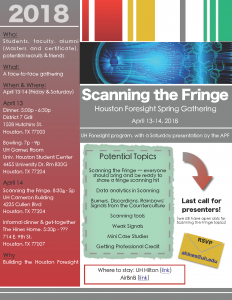 After our scan hit sharing session, which I shared about last week, we jumped into the formal program. Let’s focus on where each session suggested we might find the fringe.
After our scan hit sharing session, which I shared about last week, we jumped into the formal program. Let’s focus on where each session suggested we might find the fringe.
Graduate Assistant Kimberly Daniels and I started the day with an overview of our basic scanning process to set the context. One fringe-worthy note there is that in our projects of Houston Foresight, we’ve been adopting a tagging convention locating our scanning hits on the three horizons framework.
- So we can find the fringe in Horizon 3
Anne Boysen discussed the role of analytics in finding the fringe, where she identified steps for “Predictive Weak Signals Scanning.”
- So we can find the fringe using buried in the data using algorithms
Eric Kingsbury explored finding the fringe in the counterculture, with his aptly titled presentation “Burners, Discordians, Rainbows: SIGNALS from the Counterculture.”
- So we can find the fringe in people/groups/communities living outside the mainstream.
Natalie Pacheco and Maria Romero talked about finding the fringe on social media. They explored the “rabbit holes” of the Reddit discussion forums as well as Tumblr as part of the need to listen to new voices.
- So we can find the fringe “deep” in social media discussion forums
We ended the day with APF Chair Jay Gary highlighting the immense contribution the futurist Graham Molitor made in developed emerging issues analysis. One could argue that the entire day was really about trying to bring more specificity to the work that Molitor started decades ago.
- So we can find the fringe at the edge of the emerging issues curve, in art, fiction (esp. science, fiction, underground media, blogs, etc.
The presentations mentioned above, and others from the Scanning the Fringe meeting can be found on the Houston Foresight blog. – Andy Hines
Leave a Reply